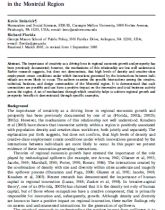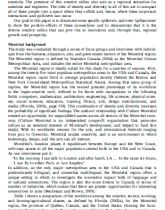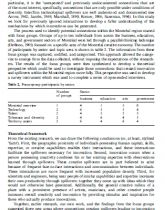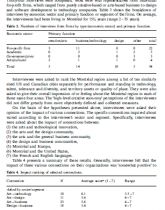Hledej
Zobraz:
Univerzity
Kategorie
Rozšířené vyhledávání
12 662
projektů
Creativity, connections and innovation: a study of linkages in the Montreal Region
| Přípona |
Typ referát |
Stažené 0 x |
| Velikost 0,2 MB |
Jazyk anglický |
ID projektu 2897 |
| Poslední úprava 27.03.2014 |
Zobrazeno 1 757 x |
Autor: eliseus |
 Sdílej na Facebooku
Sdílej na Facebooku |
||
| Detaily projektu | ||
- Cena:
2 Kreditů - kvalita:
90,6% -
Stáhni
- Přidej na srovnání
- Univerzita:Univerzita Tomáše Bati ve Zlíně
- Fakulta:Fakulta managementu a ekonomiky
- Kategorie:Ekonomika » Management
- Předmět:Management
- Studijní obor:-
- Ročník:-
- Formát:PDF dokument (.pdf)
- Rozsah A4:21 stran
Background
The importance of creativity as a driving force in regional economic growth and
prosperity has been previously documented by one of us (Florida, 2002a; 2002b;
2002c). However, the mechanisms of this relationship not well understood. Knudsen
et al (2003) have shown that innovative activity within a region is positively associated
with population density and creative-class workforce, both jointly and separately. The
explanation put forth suggests, but does not confirm, that high levels of density and
creative-class employment create conditions under which innovations generated by the
interactions between individuals are more likely to occur. In this paper we present
evidence of these innovation-generating interactions.
The importance of creativity as a driving force in regional economic growth and
prosperity has been previously documented by one of us (Florida, 2002a; 2002b;
2002c). However, the mechanisms of this relationship not well understood. Knudsen
et al (2003) have shown that innovative activity within a region is positively associated
with population density and creative-class workforce, both jointly and separately. The
explanation put forth suggests, but does not confirm, that high levels of density and
creative-class employment create conditions under which innovations generated by the
interactions between individuals are more likely to occur. In this paper we present
evidence of these innovation-generating interactions.
Klíčová slova:
creativity
economic
region
prosperity
evidence
Obsah:
- Background
Montre¨al background
Theory, methodology, and hypotheses
Theoretical framework
Results
Art ^ culture $ technology connections, confirming examples
Cultural connectionsöconfirming examples
Discussion
Implications for all regions
Future research
References
Zdroje:
- Arrow K J, 1962, ``The economic implications of learning by doing'' Review of Economic Studies
- 29 155 ^ 173
- Audretsch D B, Feldman M P, 1996, ``R&D spillovers and the geography of innovation and
- production''American Economic Review 86 630 ^ 640
- Autant-Bernard C,Massard N, 2001, ``Scientific interactions, geographic spillovers and innovation:
- an empirical study on the French case'', working paper, Centre de Recherches Economiques de
- l'Universite¨ de Saint-Etienne, Universite¨ Jean Monnet, Saint-Etienne
- Beckstead D, Brown M, 2003, ``From Labrador City toToronto: the industrial diversity of Canadian
- cities, 1992 ^ 2002'', Catalogue 11-624-MIE-No. 003, Statistics Canada, Ottawa
- Clark T N (Ed.), 2004 The City as an Entertainment Machine (Elsevier, Oxford)
- CohenW M, Levinthal D A, 1994, ``Fortune favors the prepared firm''Management Science 40
- 227 ^ 251
- DeBono E, 1985 Six Thinking Hats (Little, Brown, Boston, MA)
- Desrochers P, 2001, ``Local diversity, human creativity, and technological innovation'' Growth
- and Change 32 369 ^ 394
- Duranton G, Puga D, 2000, ``Diversity and specialisation in cities: why, where and when does it
- matter?'' Urban Studies 37 533 ^ 555
- Feldman M P, 2000, ``Location and innovation: the new economic geography of innovation,
- spillovers, and agglomeration'', in The Oxford Handbook of Economic Geography Eds G Clark,
- M Gertler, M Feldman (Oxford University Press, Oxford) pp 373 ^ 394
- Florida R, 2002a The Rise of the Creative Class (Basic Books, New York)
- Florida R, 2002b, ``The economic geography of talent''Annals of the Association of American
- Geographers 92 743 ^ 755
- Florida R, 2002c, ``Bohemia and economic geography'' Journal of Economic Geography 2 55 ^ 71
- Glaeser E L, 2000, ``The new economics of urban and regional growth'', in The Oxford Handbook
- of Economic Geography Eds GClark,MGertler,MFeldman (OxfordUniversity Press, Oxford)
- pp 83 ^ 98
- Glaeser E L, Kallal H, Scheinkman J, Shleifer A, 1992, ``Growth in cities'' Journal of Political
- Economy 100 1126 ^ 1152
- Jacobs J, 1969 The Economy of Cities (Random House, New York)
- Jaffe A B, 1986, ``Technological opportunity and spillovers of R&D''American Economic Review
- 76 984 ^ 1001
- Knudsen B, Florida R,GatesG, StolarickK, 2003,``Beyond spillovers: the effects of creative-density
- on innovation'', working paper, H John Heinz III School of Public Policy and Management,
- Carnegie Mellon University, Pittsburgh, PA
- Lee S Y, 2001, ``Innovation, human capital, and diversity'', working paper, H John Heinz III
- School of Public Policy and Management, Carnegie Mellon University, Pittsburgh, PA



